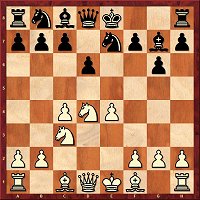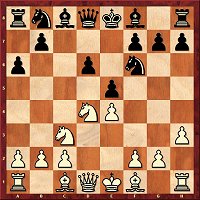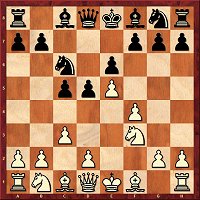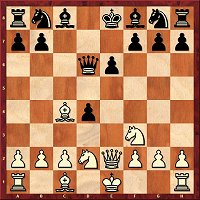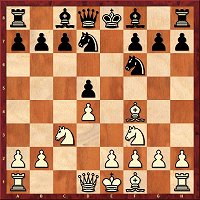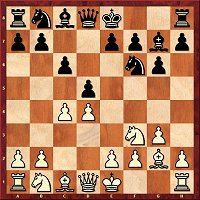|

| Intro In his introductory video Grandmaster Karsten Müllertakes a first glance over the contents of the DVD. For example, he casts some light on the decisive moments of Carlsen’s victory as White over Gelfand in the candidates tournament in London. Of the 12 openings articles on the DVD the one which particularly attracted Müller was the contribution by Zoltan Almasi on the Parma Variation in the Nimzo-Indian Defence. |
|
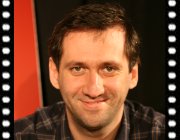
| Tournament highlights Dorian Rogozenco devotes the first of his two highlights videos entirely to the candidates tournament. For example, he presents Aronian’s fantastic endgame victory over Gelfand. A further focus of Rogozenco’s attention in this video is Kramnik’s various opening innovations in London. For the second video the Romanian GM has, e.g., picked out Topalov’s win over Nakamura (Zug) and Aronian’s brilliant victory against Svidler’s Grünfeld Defence (Paris/St Petersburg). |
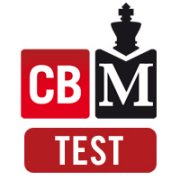
| Pure Training Here we have collected all games with training questions. By clicking at the icon you get by chance one position with a training question. |
21.04.-01.05.2013 
Levon Aronian
Victor thanks to fewer drawn games
| Aljechin-Memorial Paris/St Petersburg It will hardly have been a real consolation for Levon Aronian, but at least some sort of satisfaction. At the WCh Candidates Tournament (see below) he still had good chances of victory in the tournament after the first flight of games, but then decisively fell behind. However, in the Alekhine Memorial he managed to win the tournament ahead of Boris Gelfand who had the same number of points, and he achieved this not only ahead of Kramnik but also of World Champion Anand. As in the candidates tournaments the deciding criterion in the Alekhine Memorial was also the number of games won. |

Aronian - Kramnik,V
Position before 17.Qe3
| In achieving victory Levon Aronian also had his revenge on Vladimir Kramnik. In the candidates tournament he had faced bitter defeat in his game as White against the ex world champion (see Karsten Müller’s endgame analysis on the DVD). In St. Petersburg the Armenian decided to tackle Kramnik’s fortifications in a different way. In his analysis on the DVD Aronian explains the plan which he followed starting from the position in the diagram: with the move 17.Qe3 White clears the way for his own f-pawn. The aim is to exchange this pawn for the black e-pawn and thus to create a strong passed pawn on the d-file. And that is what happened in the game! Click on the link under the diagram and have Levon Aronian explain to you how he went about winning. |

Boris Gelfand
Good form, good humour
| Without Magnus Carlsen, against whom Boris Gelfand lost both his games in London, the latest WCh challenger would have been practically unbloodied over the last few months. The good form he had had in London was confirmed in impressive fashion in the Alekhine Memorial. Gelfand was the only player to remain undefeated and ended the tournament on the same number of points as the victor thanks to two wins against Adams and Ding Lirem. |
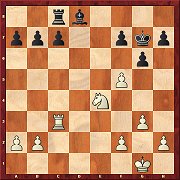
Gelfand - Adams,M
Position after 24...Kg7
| On the DVD Boris Gelfand annotates his third-round win against Michael Adams who had made an excellent start. The Israeli was successful in this game with the rare Bf4-variation of the Queen’s Gambit. Gelfand created his decisive advantage in the position in the diagram by means of a little dance with his knight: 25.Nd6 Rb8 26.Ne8+ Kf8 27.fxg6 hxg6 28.Nxc7 first of all won him a pawn. And because after 28...Bf6 29.Rb3 Adams took the wrong decision in the form of 29...Be5 – the more active defence with 29...Rd8 was the right idea – Gelfand was able to find an effective post for his knight on d3 and then go on to realise his advantage one bit at a time. A brilliant game for which the veteran received the prize for the best technique! |
18.04.-30.04.2013 
Veselin Topalov
Clear winner
| FIDE Grand Prix Zug In April the FIDE cycle saw its third event take place in the Swiss town of Zug. Unlike the previous tournaments in London and Tashkent there was no neck and neck finish on this occasion. With his victory over the pursuing Caruana in penultimate round Veselin Topalov secured himselfsole victory in the tournament with a round to go and on the following day even scored another win, over Karjakin this time. You will find on the DVD two games by the victor annotated by GM Krasenkow. |

Caruana annotates
Kamsky - Caruana
| In the Kamsky-Caruana game the contestants found themselves in new territory as far as the American was concerned in a Ruy Lopez after the rare 9.Be3 and 10.axb5. In his analysis Fabiano Caruana takes a detailed and microscopic look at the (in no way error-free) opening play of both sides. The decisive mistake was made by Kamsky in an already worse position (see diagram). After 33.Qe3 the black queen forced the decision with 33...Qa1 34.Kf3 Qd1+ 35.Qe2 Qh1+ 36.Ke3 Qxd5. |

Ponomariov - Kamsky
Position before 29.d5
| Ruslan Ponomariov also managed to defeat Gata Kamsky. The Ukrainian explains in his analysis on the DVD, how he used various transpositions of moves to entice his opponent into an opening variation with which he was not too familiar (in the Nimzo-Indian Defence) and promptly took advantage of an inaccuracy on his part. In fact, in the subsequent play Ponomariov got more space and the better game. On move 29 the found the position ripe for a decisive strike: after the breakthrough 29.d5 Kamsky went wrong with 29...f5 30.exf6 Rxf6 (followed by 31.Re1), but even after 29...exd5 30.e6 the black position could no longer have been held. |
15.03.-01.04.2013 
Magnus Carlsen
to challenge the world champion
| WCh Candidates Tournament London In London in March it became clear that a candidates tournament belongs to quite a different category from all “normal” supertournaments which one can see and admire in any year with a similar cast list. For example, at the end of the tournament Magnus Carlsen lost twice with the white pieces. And even that was finally enough to win the tournament, last but not least because his keenest rival, Vladimir Kramnik, had believed that in the final round he had to play for a win at all costs. But in the long run it was this defeat which cost the ex world champion his ticket to India. |

Carlsen - Gelfand
Position after 23.b2-b4
| On the DVD Carlsen’s second Peter-Heine Nielsen annotates the first and of course enormously important win by the new WCh challenger in the third round. The analysis is presented as a personal vote of thanks by Magnus Carlsen to his helpers and above all to Peter-Heine Nielsen. In the game Carlsen chose in the Rossolimo Variation (3.Bb5) with rapid kingside castling and the retreat of the bishop to f1 a long-term and positional plan. In the position on the left the Norwegian’s long-range vision was correct as he chose the risky looking 23.b2-b4. At this point he would already have seen the winning queen shift on move 28 from h5 to a5, a square which was even still being threatened by the rook! |
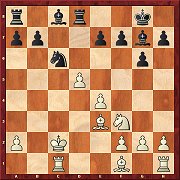
Kramnik - Svidler
Position after 14.Kd2-c2
| For over 10 years Vladimir Kramnik had been carrying around with him an innovation in the Grünfeld Defence Exchange Variation. In London the time had come. He had White against Peter Svidler and he deviated from the then main move 14.Ke1 to move his king on to a square which it had never yet occupied in this variation. After Svidler’s solid but slightly passive reply 14...Ne5 and the exchange of knights Kramnik obtained an objectively somewhat better position and at the same time made the most of the advantage given by his home preparation. Play through the game and enjoy the great win and the comments by the previous world champion! |
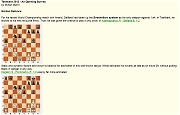
Openings report
| Almost all the games from the candidates tournament are commented on extensively on the DVD. In addition, Romanian grandmaster Mihail Marin has brought together for you in his Openings report the latest trends and ideas. As well as Marin, grandmasters such as Krasenkow, Mikhalchishin, Postny, Stohl and Szabo have contributed analyses. |

Round-up Shows with
Daniel King
| On the DVD you will also find all the round by round analyses from the London candidates tournament, by GM Daniel King in ChessMedia format. |
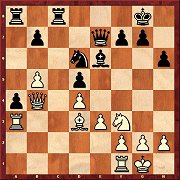
Georgiev-Dvirnyy, Skopje
Position after 22.Qb4
In tactics, frequently the small things are what decide a game. Here, how does Black manage not to lose his a4-pawn? Solution only in the tactics column.
| From the opening trap to the endgame study Training in ChessBase Magazine begins with the very first moves and takes in all the phases of a game of chess. You can also reach the 12 up-to-date openings articles with their numerous ideas and suggestions for your repertoire above via the links. This time the Opening trap by Rainer Knaak (including its Fritztrainer video) deals with a trap in the Italian Game (C56). You can also find in video format the openings contributions by Viktor Bologan (Caro-Kann Main Variation) and Andrew Martin (Queen’s Gambit Exchange Variation). Take a look at the contents in the column on opening videos. Daniel King’s long-running Move by Move column takes as its subject the Ruy Lopez game Svidler-Carlsen. This time it is presented completely in the new interactive video format. The subject tackled by Dorian Rogozenco in his strategy column is: "Open files". And in the tactics (subject: pawn power in front of the opposing king) and endgame (subject: knight magic) columns Oliver Reeh and Karsten Müller have once again brought together all that is best from recent tournament practice. |



















